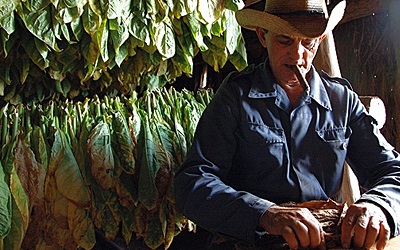Tour Highlights
-
 Viñales valley and a section of this Mountain Range where it is located became in 1999 a National Park and was declared by UNESCO a World Heritage Site in the category of Cultural landscape. This overwhelming landscape houses 17 botanical species and 47 archeological sites, most of them related to aboriginal communities and runaway African slaves. It features unique gigantic limestone hillocks, mogotes, honeycombed with cavities which resemble a huge church organ, therefore the name Sierra de los Organos, Organs Mountain Range.
Viñales valley and a section of this Mountain Range where it is located became in 1999 a National Park and was declared by UNESCO a World Heritage Site in the category of Cultural landscape. This overwhelming landscape houses 17 botanical species and 47 archeological sites, most of them related to aboriginal communities and runaway African slaves. It features unique gigantic limestone hillocks, mogotes, honeycombed with cavities which resemble a huge church organ, therefore the name Sierra de los Organos, Organs Mountain Range.
-
 This cave
discovered in 1920, lies in the San Vicente Valley. The first part of the tour here is on foot and then a motorboat takes visitors through a river which runs inside the cave. It´s plenty of gorgeous stalactites and stalagmites, some of which resemble animals, ships, skull, etc.
This cave
discovered in 1920, lies in the San Vicente Valley. The first part of the tour here is on foot and then a motorboat takes visitors through a river which runs inside the cave. It´s plenty of gorgeous stalactites and stalagmites, some of which resemble animals, ships, skull, etc. -
 Located at Dos Hermanas Valley, this spectacular Mural (120 meters high and 160 meters long) was painted by Leovigildo Gonzáles Morillo who was Chief Cartographer of the Cuban Academy of Science. The face of a limestone hillock features the history of local evolution from ammonites to Hommo Sapiens.
Located at Dos Hermanas Valley, this spectacular Mural (120 meters high and 160 meters long) was painted by Leovigildo Gonzáles Morillo who was Chief Cartographer of the Cuban Academy of Science. The face of a limestone hillock features the history of local evolution from ammonites to Hommo Sapiens. -
 In the depths of San Miguel´s cave, there is a Palenque, run away refuge, which houses a museum now. Cimarrones were runaway slaves who hid in the mountains or forests to avoid those whose job it was to capture them alive or dead. These fugitives organized frequent revolts which were almost inevitably suppressed with bloodshed.
In the depths of San Miguel´s cave, there is a Palenque, run away refuge, which houses a museum now. Cimarrones were runaway slaves who hid in the mountains or forests to avoid those whose job it was to capture them alive or dead. These fugitives organized frequent revolts which were almost inevitably suppressed with bloodshed. -
 They are among the most ancient rocks in Cuba and all what remains of a limestone plateau. Over a period lasting millions of years, underground aquifers eroded the softer limestone giving rise to large caverns whose ceiling later collapsed. Only the hard lime stone pillars, mogotes, were left standing. They are covered with thick vegetation where some endemic plant species have adapted to life on their craggy crevices.
They are among the most ancient rocks in Cuba and all what remains of a limestone plateau. Over a period lasting millions of years, underground aquifers eroded the softer limestone giving rise to large caverns whose ceiling later collapsed. Only the hard lime stone pillars, mogotes, were left standing. They are covered with thick vegetation where some endemic plant species have adapted to life on their craggy crevices. -
 In Cuba, the
process of tobacco growing is the result of age old expertise handed
down to generations. Tobacco plants are very delicate and need skilful handling. There two types: Corojo, grown in green houses, which has the finest leaves, selected as the cigar´s wrapper, and Criollo, which grows outdoors and provides the cigar´s filler and its binder. Harvesting tobacco is a laborious operation. The leaves are tied in bunches and put to dry in sheds hanging on horizontal poles. Humidification is a hydrating process carried out after the drying so that the leaves do not dry out.
In Cuba, the
process of tobacco growing is the result of age old expertise handed
down to generations. Tobacco plants are very delicate and need skilful handling. There two types: Corojo, grown in green houses, which has the finest leaves, selected as the cigar´s wrapper, and Criollo, which grows outdoors and provides the cigar´s filler and its binder. Harvesting tobacco is a laborious operation. The leaves are tied in bunches and put to dry in sheds hanging on horizontal poles. Humidification is a hydrating process carried out after the drying so that the leaves do not dry out.

 1
1 2
2 3
3 4
4 5
5 6
6








